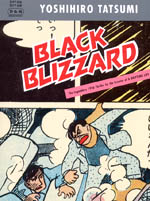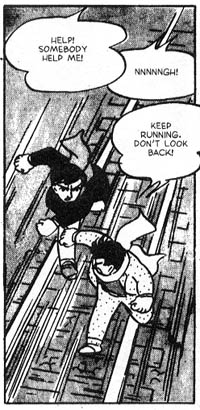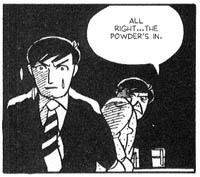 By Yoshihiro Tatsumi
By Yoshihiro Tatsumi
136 pages, black and white
Published by Drawn & Quarterly
Drawn & Quarterly, over the past few years, has dipped its toe into translating manga into English, primarily the works of creator Yoshihiro Tatsumi. Books like Tatsumi’s autobiography A Drifting Life and short story collections Abandon the Old in Tokyo have proven to be fascinating, looking at his attempts to break free of genre and industry constraints at the time. So when Drawn & Quarterly announced Black Blizzard, Tatsumi’s debut graphic novel, I was intrigued. (And not just because the creation of Black Blizzard is part of the time period retold in A Drifting Life.) What I found, though, was a creator that shows talent but was still beginning to learn his craft.
 Black Blizzard is a fairly typical crime noir story; two wanted criminals on the run, handcuffed together, even as one of them appears to be a genuinely good person. It’s a far cry from his short stories, which are punctuated by unpredictability and a general off-beat nature. At this point in his career, Tatsumi stands out not from inventiveness, but being able to create a tense situations. Black Blizzard is at its best when the characters are on the run from the authorities, with the thrill of the chase. As Susumu and Shinpei run through the snowy wilderness and try to build a fire, you get the sense that anything can happen. And of course, with the ever-present handcuffs connecting the two, the threat of how to get the pair separated looms forever overhead.
Black Blizzard is a fairly typical crime noir story; two wanted criminals on the run, handcuffed together, even as one of them appears to be a genuinely good person. It’s a far cry from his short stories, which are punctuated by unpredictability and a general off-beat nature. At this point in his career, Tatsumi stands out not from inventiveness, but being able to create a tense situations. Black Blizzard is at its best when the characters are on the run from the authorities, with the thrill of the chase. As Susumu and Shinpei run through the snowy wilderness and try to build a fire, you get the sense that anything can happen. And of course, with the ever-present handcuffs connecting the two, the threat of how to get the pair separated looms forever overhead.
The book slows down, though, once we get a lengthy flashback to Susumu’s love story that got him landed in hot water in the first place. While it’s obvious from day one that Susumu wasn’t really a murderer, this hammers it home just in case anyone was doubting. By the time we see the end of this relatively straight forward and innocent story of Susumu trying to help a circus ringmaster’s daughter (and falling in love), Black Blizzard has lost a lot of its steam, and the book never fully rallies back up to its earlier potential. There are a couple of strong moments in the second half, but the thrill itself is so much less that it’s not the same level of fun. Tatsumi himself seems to lose interest in his own story as well, the last handful of pages being told in a matter-of-fact manner, the resolution to the entire story having happened off-panel. It’s a weak ending to a book that started out so well.
 Tatsumi’s early art is blocky and crude in places, but there’s an energy about it that helps propel those early pages forward. Watching the duo of wanted men running down the train tracks feels fast-paced, and brings that urgency further to life. It’s probably the best thing about Tatsumi’s art, and certainly goes a long way towards explaining why the flashback scenes don’t work quite as well. There we get the same expression on Susumu’s face no matter what the occasion; it’s definitely not up to the later standards of Tatsumi’s work, and the high quality that readers now have come to expect from him.
Tatsumi’s early art is blocky and crude in places, but there’s an energy about it that helps propel those early pages forward. Watching the duo of wanted men running down the train tracks feels fast-paced, and brings that urgency further to life. It’s probably the best thing about Tatsumi’s art, and certainly goes a long way towards explaining why the flashback scenes don’t work quite as well. There we get the same expression on Susumu’s face no matter what the occasion; it’s definitely not up to the later standards of Tatsumi’s work, and the high quality that readers now have come to expect from him.
Had I never seen anything else by Tatsumi before, I might have felt that Black Blizzard was all right but nothing out of the ordinary. Knowing the growth in his career to come, though, it’s interesting to look at this as a historical footnote, trying to pick out the eventual hallmarks and signs of what he would become best-known for. Tatsumi completists will want to take a look at Black Blizzard, but as an initial introduction to his work, there are much better places to start. Hopefully we’ll get more collections of his short stories down the line; this was a fun detour into the start of his career, but I’d rather see more of his work once he’d become a stronger writer and artist.
Purchase Links: Amazon.com | Powell’s Books
